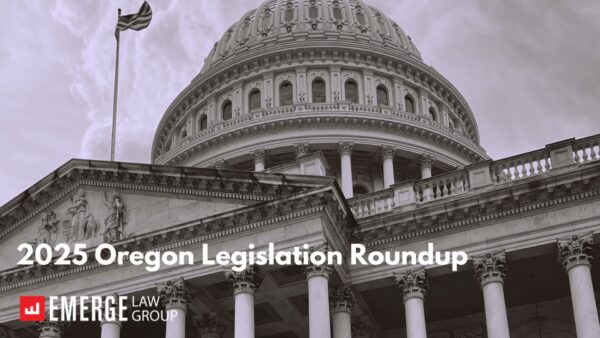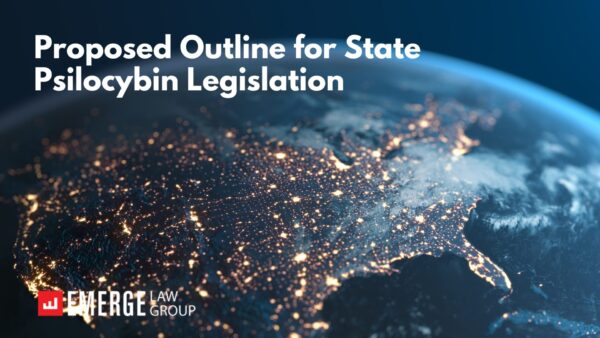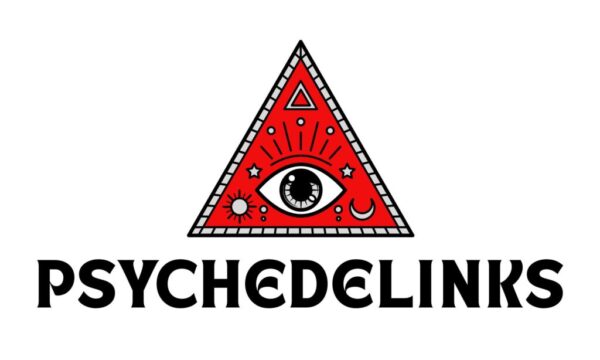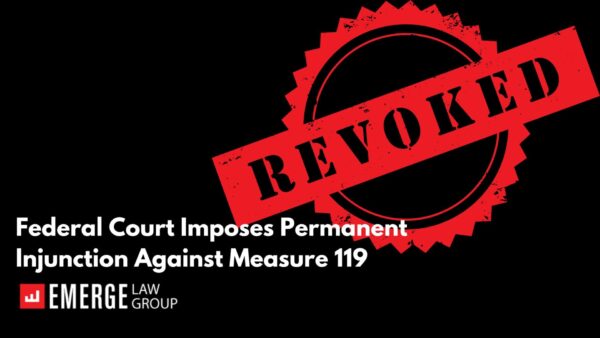The initiative petition formerly known as Oregon Initiative Petition 2020-034 has been rebranded as Oregon Measure 109. And with seven weeks to go until Election Day, things are beginning to ramp up. The Yes on 109 organization released an animated video that provides a general overview of Measure 109, and various campaign ads are on the way. Yes on 109 also has compiled an impressive number of endorsements. Additionally, the Oregonian recently published a rather lengthy and interesting article focusing on psilocybin, Measure 109, and Navy SEAL Chad Kuske’s experiences with psilocybin therapy.
An Explanatory Statement Committee (which included me, Yes on 109’s campaign manager Sam Chapman, Deschutes County Sheriff Shane Nelson, Kevin Walruff, and Judy Hall) certified an official Explanatory Statement for Measure 109 that will appear in the Oregon Voters’ Pamphlet, which is scheduled to be posted the week of October 5.
This blog is the first in a series of substantive explanations of Measure 109 that we will publish before Election Day. As mentioned in a previous blog, Measure 109 is a long measure totaling 71 pages and containing 134 sections. The complete text can be found here.
This blog will discuss Measure 109’s two-year development period. The two-year development period is a significant enough feature of Measure 109 that the Oregon Department of Justice included a reference to it in the 15-word limit caption that will appear in the Voters’ Pamphlet.
The two-year development period is tantamount to a significant “delayed effective date.” The two-year development period technically begins on January 1, 2021 and ends on December 31, 2022. As a result, Measure 109’s licensing and regulatory program will not be implemented until 2023. Further, Measure 109 will not change any criminal or other laws regarding the actual manufacture, delivery, or possession of psilocybin until 2023.
There were several purposes behind the two-year development period. First, as a practical matter, a longer period between passage and implementation will provide the Oregon Health Authority (“OHA”) with more time to adopt rules implementing Measure 109. Oregon Measure 91, which was passed by Oregon voters in 2014 and which legalized the adult use of marijuana, contained a roughly one-year deadline for its implementation. This was a relatively short time frame, given that both the Oregon Liquor Control Commission (the “OLCC”) and the Oregon State Legislature (the “Legislature”) had a significant “learning curve” with respect to regulating the adult use of marijuana. The result was that the implementation of Measure 91 probably did not go as smoothly as it could have. The idea behind the two-year development period is to better ensure that the OHA is not rushed into rulemaking and that the implementation of the regulatory program under Measure 109 will take place in a more methodical manner.
A second and related purpose is to simply give everyone (the public, the OHA, and the Legislature) more time to become better educated about psilocybin. Two important educational undertakings will occur during the two-year development period: (i) the OHA will publish and make available to the public medical, psychological, and scientific studies, research, and other information relating to the safety and efficacy of psilocybin in treating mental health conditions; and (ii) a newly-created Oregon Psilocybin Advisory Board (the “Advisory Board”), which will be comprised of a broad cross-section of health experts, regulatory experts, and other Oregonians, will develop best practices and make recommendations to the OHA.
A third purpose is to give both the Legislature and the federal government the opportunity to take a “wait and see approach” and to do nothing, at least for a while. As a result of Measure 91’s relatively short deadlines, the 2015 Legislature felt compelled to make a number of changes to Measure 91 before it was even implemented. Those legislative changes, in turn, caused the OLCC to delay its rulemaking hearings, making for an even more rushed adoption of rules by the OLCC. Hopefully, the 2021 Legislature will not feel the need to make any substantive changes to Measure 109 before the OHA and the Advisory Bard have a chance to develop best practices.
From the federal government’s standpoint, there is no precedent for a state adopting a licensing and regulatory program for psilocybin services. Measure 109 will be the first of its kind in the United States. A subsequent blog will discuss potential reactions by the federal government, but the hope is that the two-year development period will give the federal government some time to learn about psilocybin and Measure 109 before it feels compelled to issue a policy statement or take any other action.
Assuming that the Legislature and the federal government do not intervene, most of the work during the two-year development period will be undertaken by the OHA and the Advisory Board.
The Advisory Board will be established within the OHA. Measure 109 does not provide for the termination or expiration of the Advisory Board, and it is contemplated that the Advisory Board will exist on a continuing basis.
The Advisory Board will be comprised of 18 or 19 members during the two-year development period. The Governor will appoint 15 or 16 members as follows:
• Any four of the following: (i) a state employee with expertise in public health; (ii) a local health officer; (iii) a representative of an Indian tribe; (iv) a representative of the Addictions and Mental Health Planning and Advisory Council within the OHA; (v) a representative of the Health Equity Policy Committee within the OHA; (vi) a representative of the Palliative Care and Quality of Life Interdisciplinary Advisory Council within the OHA; and (vii) a representative of individuals who provide public health services to the public;
• A licensed psychologist;
• A licensed naturopathic physician;
• An expert in the field of public health who has a background in academia;
• Any three of the following: (i) a person with experience conducting scientific research regarding the use of psychedelic compounds in clinical therapy; (ii) a mycologist; (iii) an ethnobotanist; and (iv) a person with experience in psychopharmacology; and (v) a person with experience in psilocybin harm reduction;
• A person representing the OLCC who has experience with the OLCC’s Cannabis Tracking System;
• A person representing the Oregon Department of Justice;
• One of Measure 109’s chief petitioners; and
• One or two at-large members.
There will be three additional members that are not appointed by the Governor: (i) Oregon’s Public Health Director or a designee; (ii) either: (A) Oregon’s State Health Officer or a designee; or (B) a representative of the OHA; and (iii) a designee of the Oregon Health Policy Board.
Members of the Advisory Board will serve four-year terms. Only members appointed by the Governor will have voting rights. Members that are not appointed by the Governor will be nonvoting ex officio members.
The Advisory Board will have the following duties:
• Provide advice to the OHA on all matters related to Measure 109;
• Make recommendations to the OHA on: (i) the medical, psychological, and scientific studies, research, and other information that the OHA should publish and make available to the public; (ii) the requirements, specifications, and guidelines for providing psilocybin services to a client; (iii) public health and safety standards and industry best practices; (iv) a code of professional conduct for psilocybin service facilitators; (v) the education and training that psilocybin service facilitators must complete; and (vi) the examinations that psilocybin service facilitators must pass;
• Develop a long-term strategic plan for ensuring that psilocybin services become and remain a safe, accessible, and affordable therapeutic option in Oregon;
• Monitor federal laws, regulations, and policies regarding psilocybin; and
• Attempt to the meet with the United States Attorney’s Office for the District of Oregon to discuss Measure 109.
The Advisory Board will meet at least once every two calendar months during the two-year development period.
Measure 109’s timelines during the two-year development period are as follows:
• February 28, 2021 – The Governor appoints members of the Advisory Board.
• March 31, 2021 – The Advisory Board holds its first meeting.
• June 30, 2021 – The Advisory Board makes recommendations to the OHA on studies, research, and educational information.
• July 31, 2021 – The OHA first publishes studies, research, and educational information.
• June 30, 2022 – The Advisory Board makes recommendations to the OHA regarding: (i) rules and regulations; (ii) a long-term strategic plan; and (iii) federal laws and policies.
• December 31, 2022 – The OHA adopts rules and regulations and prescribes license application and other forms.
And then, finally, on January 2, 2023, the OHA will begin receiving the first license applications. Presumably, the first psilocybin licenses will be issued sometime during the first half of 2023.
More blogs about Measure 109 will follow in the coming weeks as Election Day approaches.
If you have questions concerning Measure 109 or any other laws involving psilocybin, entheogenic plants, or psychedelics in general, please contact attorneys Dave Kopilak, Kathryn Tucker, Sean Clancy, Kaci Hohmann, or Kaitlyn Dent from our Psychedelics Practice Group.




